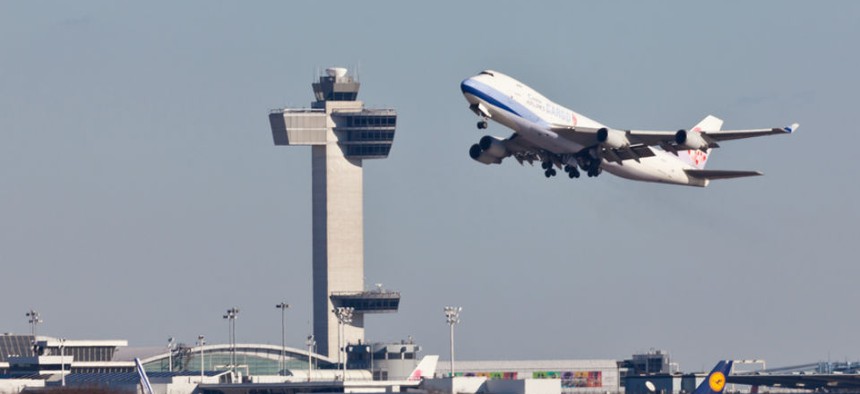
Chris Parypa Photography / Shutterstock.com
Lawmaker Moves to Remake Air Traffic Control as a Corporation
Mica's draft bill inspired by foreign quasi-government systems.
As managed by the Federal Aviation Administration, the nation’s air traffic control system has for decades prompted complaints about faltering funding from Congress and a top-heavy bureaucracy that is slow to exploit new technology.
With Congress gearing up to reauthorize the FAA by September, Rep. John Mica, R-Fla., is taxiing down the legislative runway with a plan to transform the current “dysfunctional” system by moving much of its management of 15,000 employees out of government and into a new corporation. His proposal would be a variation on a system already in use in Canada and the United Kingdom.
At a March 24 hearing of the Transportation and Infrastructure Aviation Subcommittee, Mica—onetime chairman of the full panel--unveiled a discussion draft of the Air Traffic Controller Reform and Employee Stock Ownership Act.’ It would allow stakeholders, including current air traffic controllers, airlines and users, to operate a new air traffic control system.
“The time to stop talking is now,” Mica said. “The time to act, and act boldly, is now.”
Among the draft’s provisions are plans to set up private corporations operating in each state, and to task the Transportation secretary with determining who of senior management in air traffic control services will be transferred to the corporation and who shall continue at the FAA. Those remaining would not “exceed 1 percent of the total number of air traffic control personnel,” the draft stated.
The secretary would also determine what property transferred to the corporation and would work with the Office of Personnel Management on the personnel shifts “including any necessary reduction in force actions and severance benefits that may be necessary to carry out this act.”
Mica stressed that he is awaiting reactions before introducing the official bill on April 16.
The idea of handing management of air traffic control over to some type of extra-governmental body drew support from witnesses from the airline industry and past FAA officials.
Promising fee-funded models in Canada, the United Kingdom, Germany and France were described to the panel by Matthew Hampton, assistant inspector general for aviation at the Transportation Department, though he noted that the technological changes they make tend to be incremental—far less ambitious than the NextGen modernization project under way at the FAA.
Craig Fuller, a pilot who recently ran a study group as vice chairman of the FAA Management Advisory Council, said the time is ripe to consider a federal corporation run by an independent governing board that would be “bold” and “transformational.” He advocated an approach that “changes the governance structure allows for the executive leadership to manage the entire agency with clearer objectives and standards set by a fully engaged board with aviation experience that would…provide consensus on priorities matched with clear metrics around performance.”
American Airlines CEO Douglas Parker, representing the airlines industry, also called for transformation, stressing that the new entity should include “independent, multi-stakeholder board governance; effective management teams incentivized to pursue efficiencies without the constraints imposed on government agencies that hamper their ability to manage more nimbly and effectively; a fair self-funding model based on the cost of ATC services and free from budget constraints and short-term, declining appropriations; and the ability to manage assets and capital in a way that allows far greater speed to market of technological modernization.”
The National Air Traffic Controllers Association, which has long argued that air traffic control is an inherently governmental function, took a more agnostic stance. “NATCA looks forward to working with Congress and other stakeholders to determine a solution that protects air traffic control and secures it for future growth,” said President Paul Rinaldi. “No system is like the United States’ and no model used elsewhere in the world is perfect, much less for a system as large, complicated and diverse as ours,” he said. Rinaldi insisted, however, that no alternative entity should be profit-making, which, he testified, would cut corners on safety and reduce service to rural areas.
Mica’s draft bill would move in the wrong direction by setting up a corporation, Ron Taylor, president of the Professional Air Traffic Controllers Organization, told Government Executive. “The first thing you do with any corporation is cut costs, and that means the loss of thousands of jobs,” Taylor said. “It’s very important that the national air space be controlled by the government, for reasons of national security. You want a corporation running that? Who’s the real boss? Who owns this?”
The FAA did not respond to Government Executive queries, but Rich Swayze, its assistant administrator for policy, international affairs and environment, told a conference in December that the agency had not settled on a specific reorganization plan and warned that Canada and Britain took years to make the transition. “I don’t think any other country provides an exact plan for how we have transformational reform in the U.S.,” Swayze said.
(Image via Chris Parypa Photography / Shutterstock.com)







